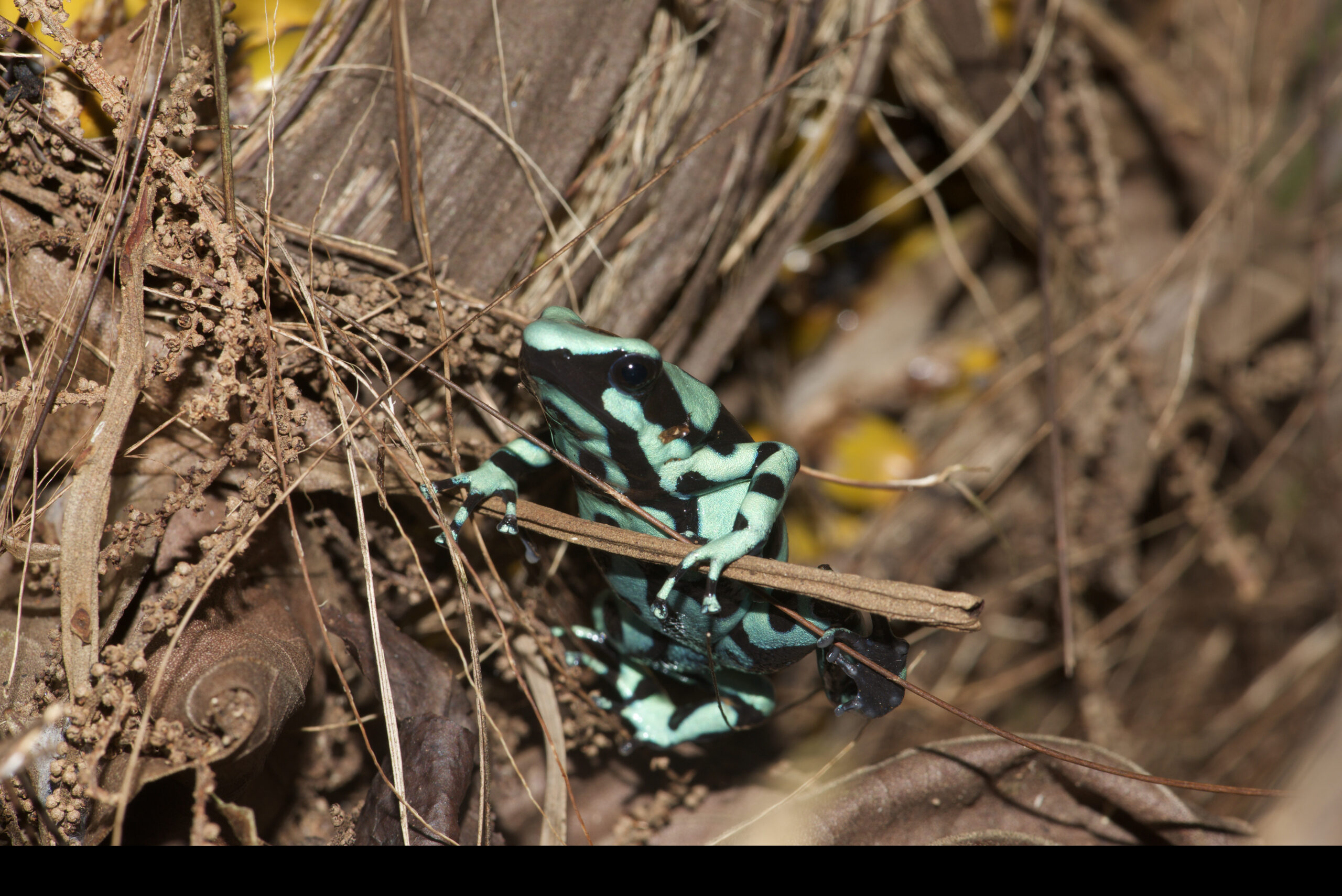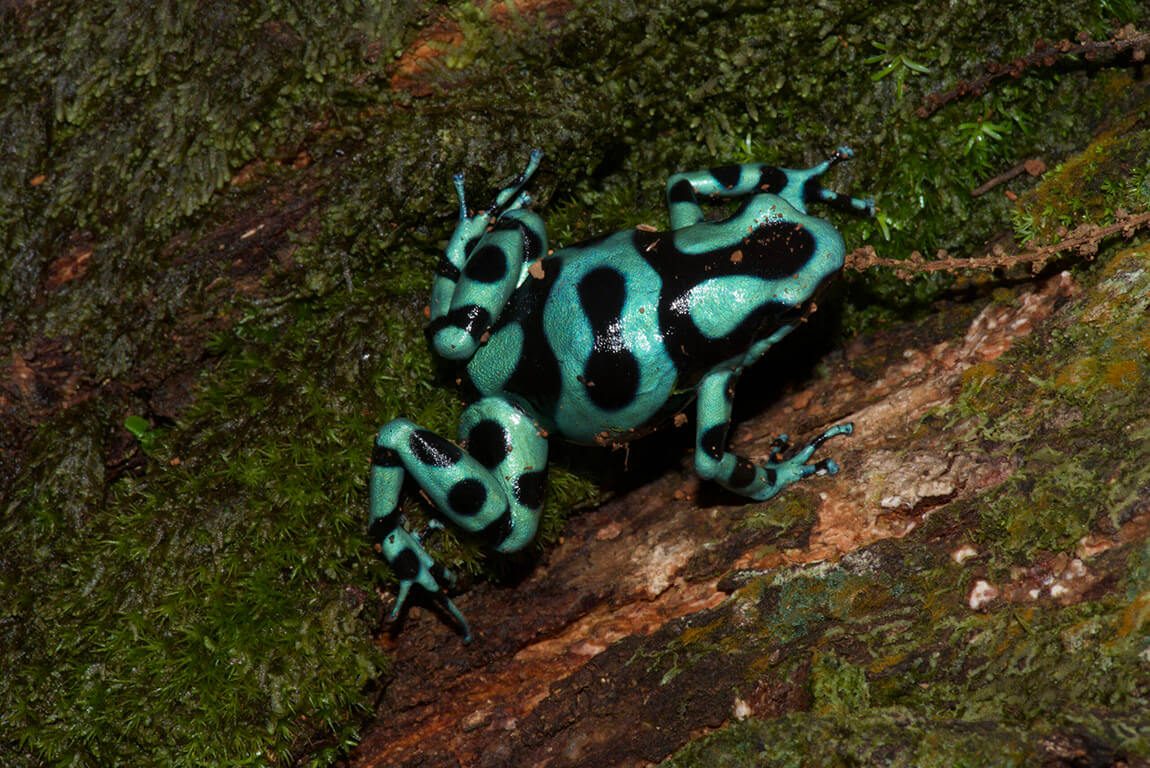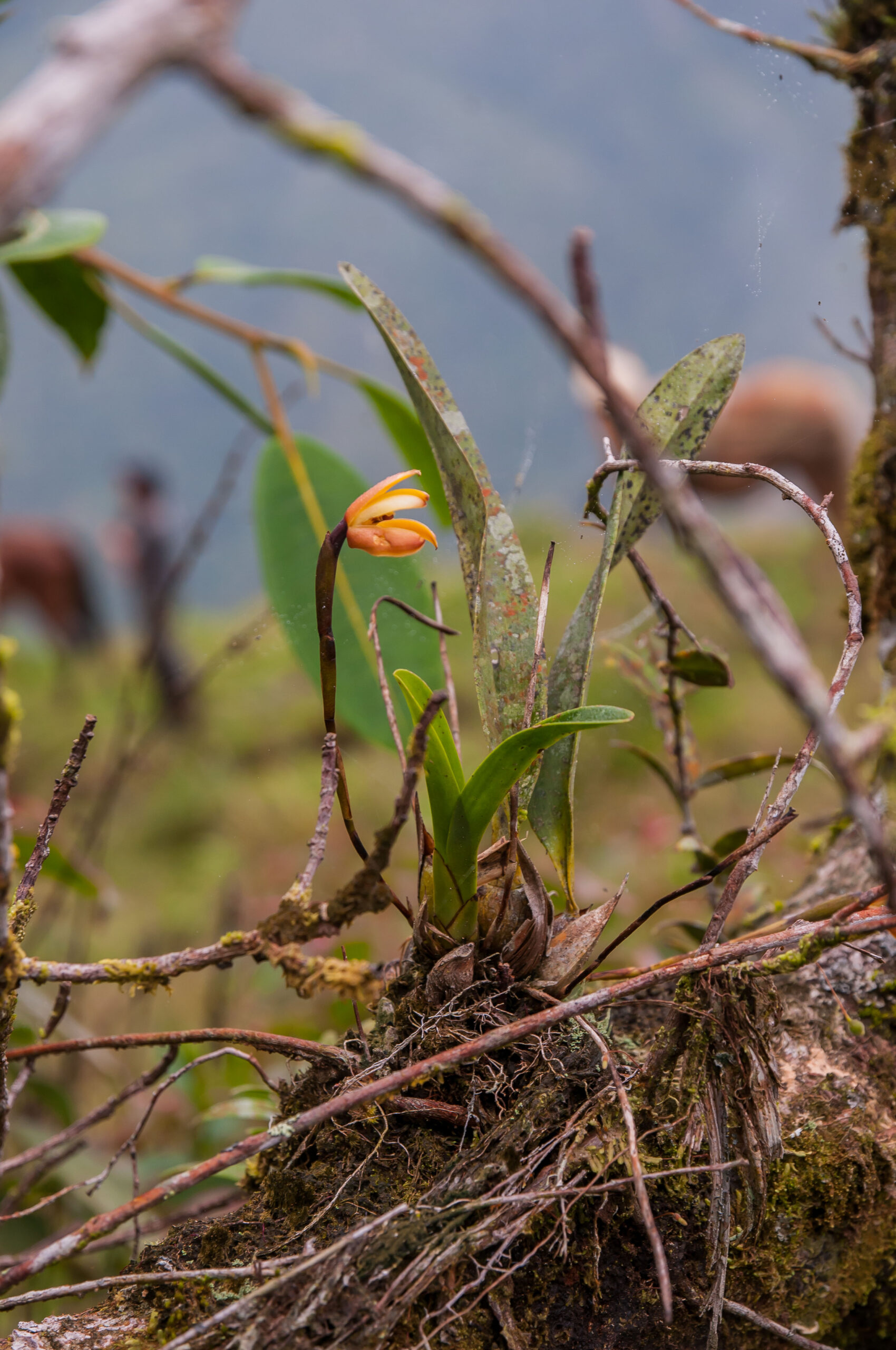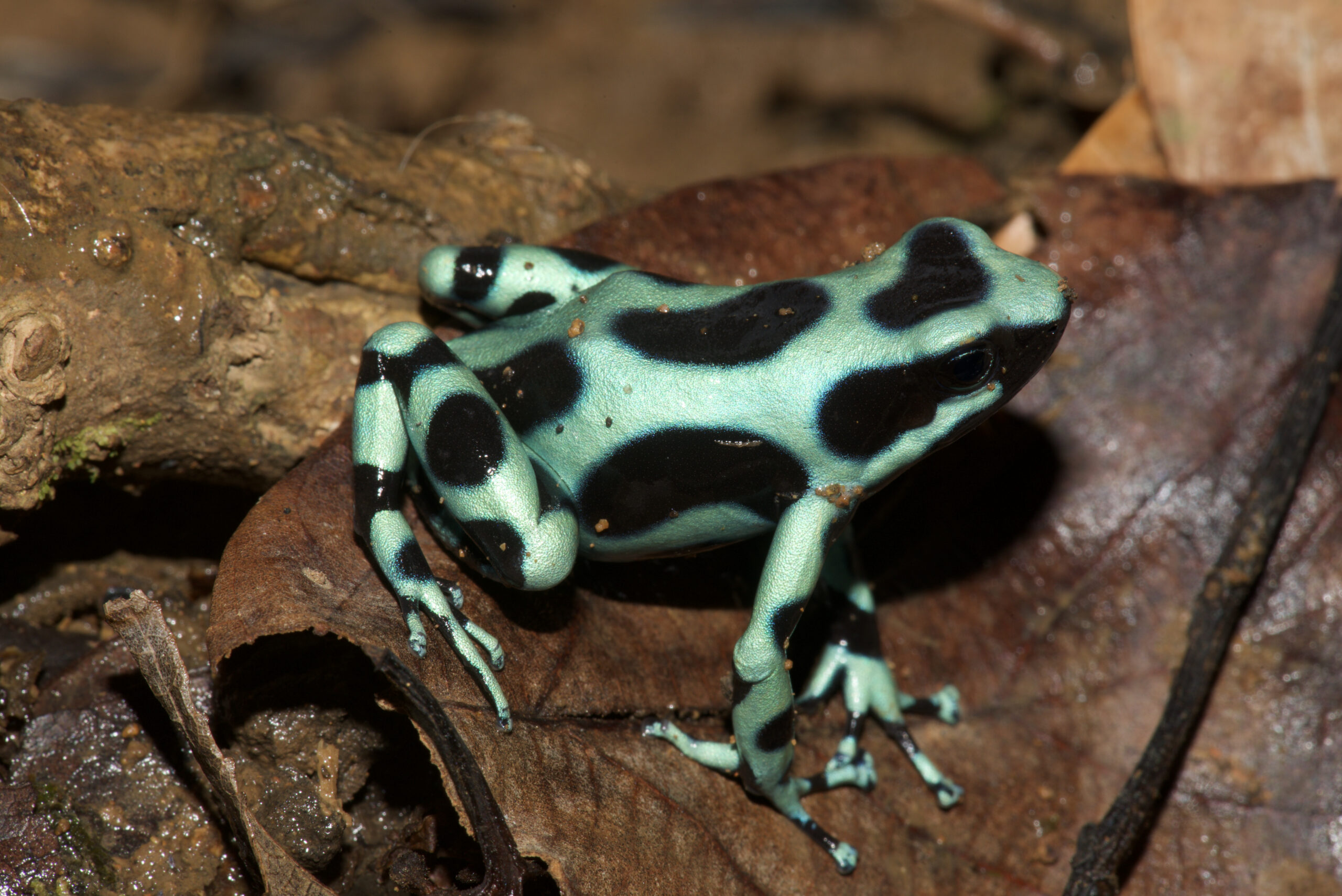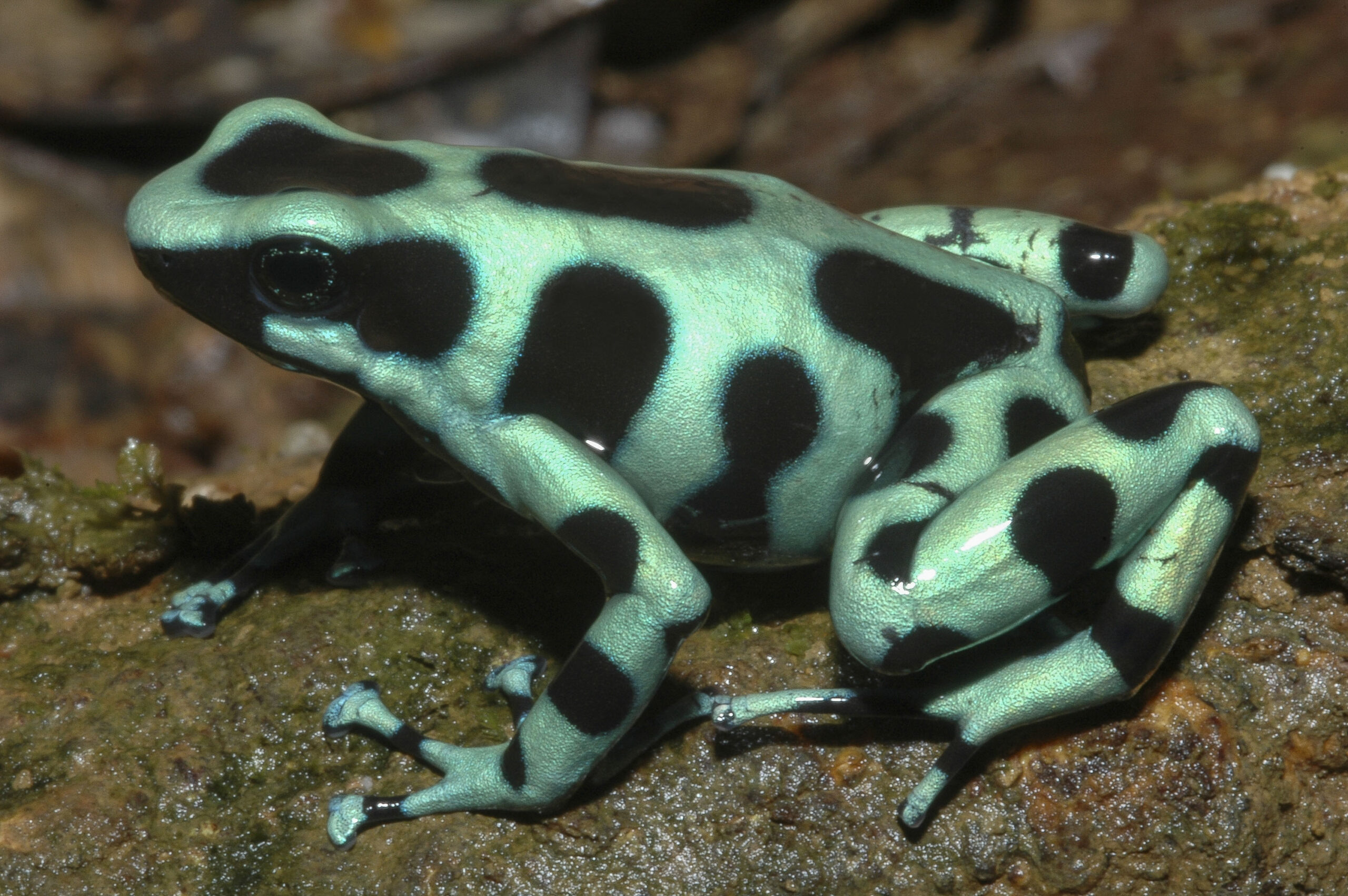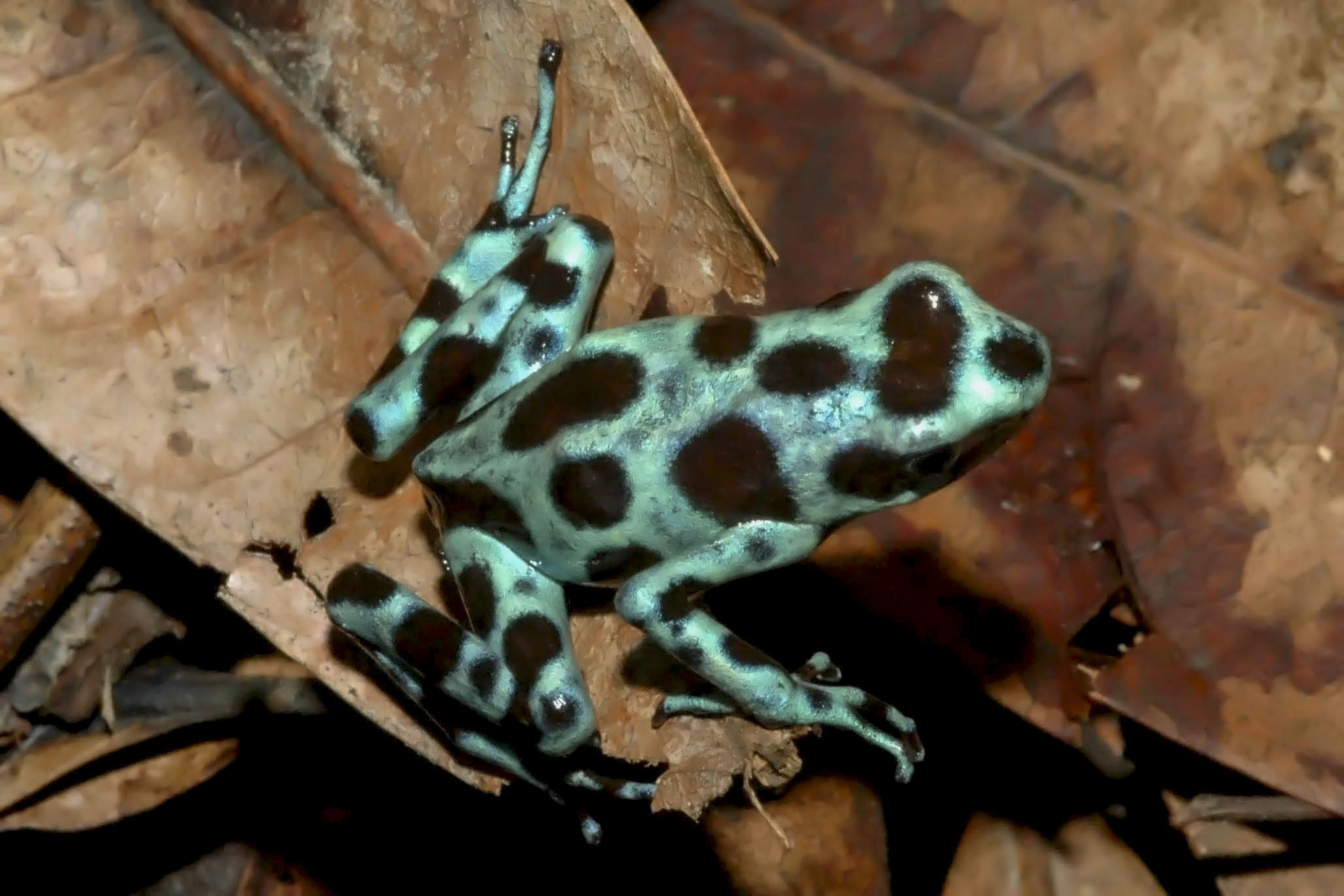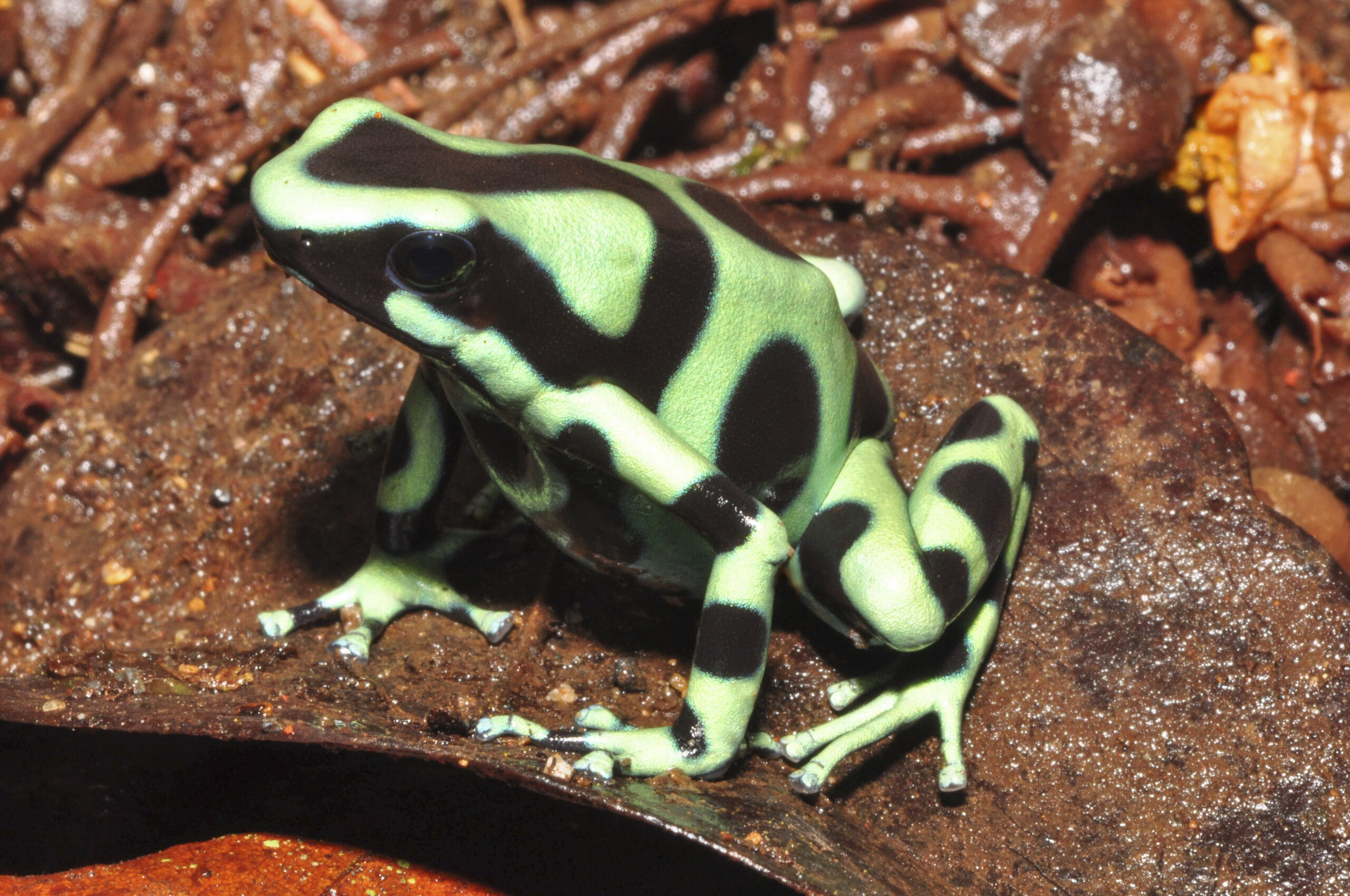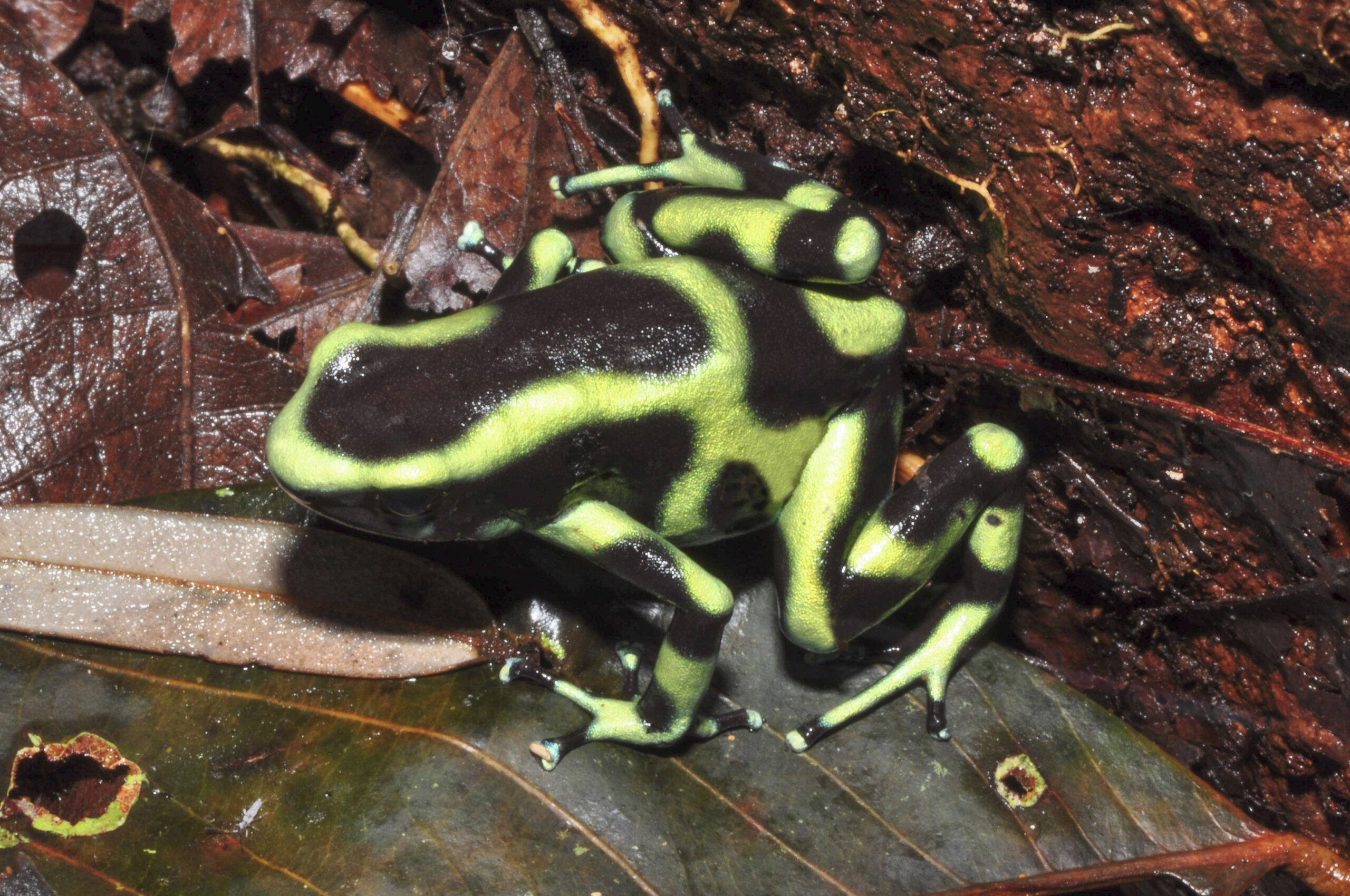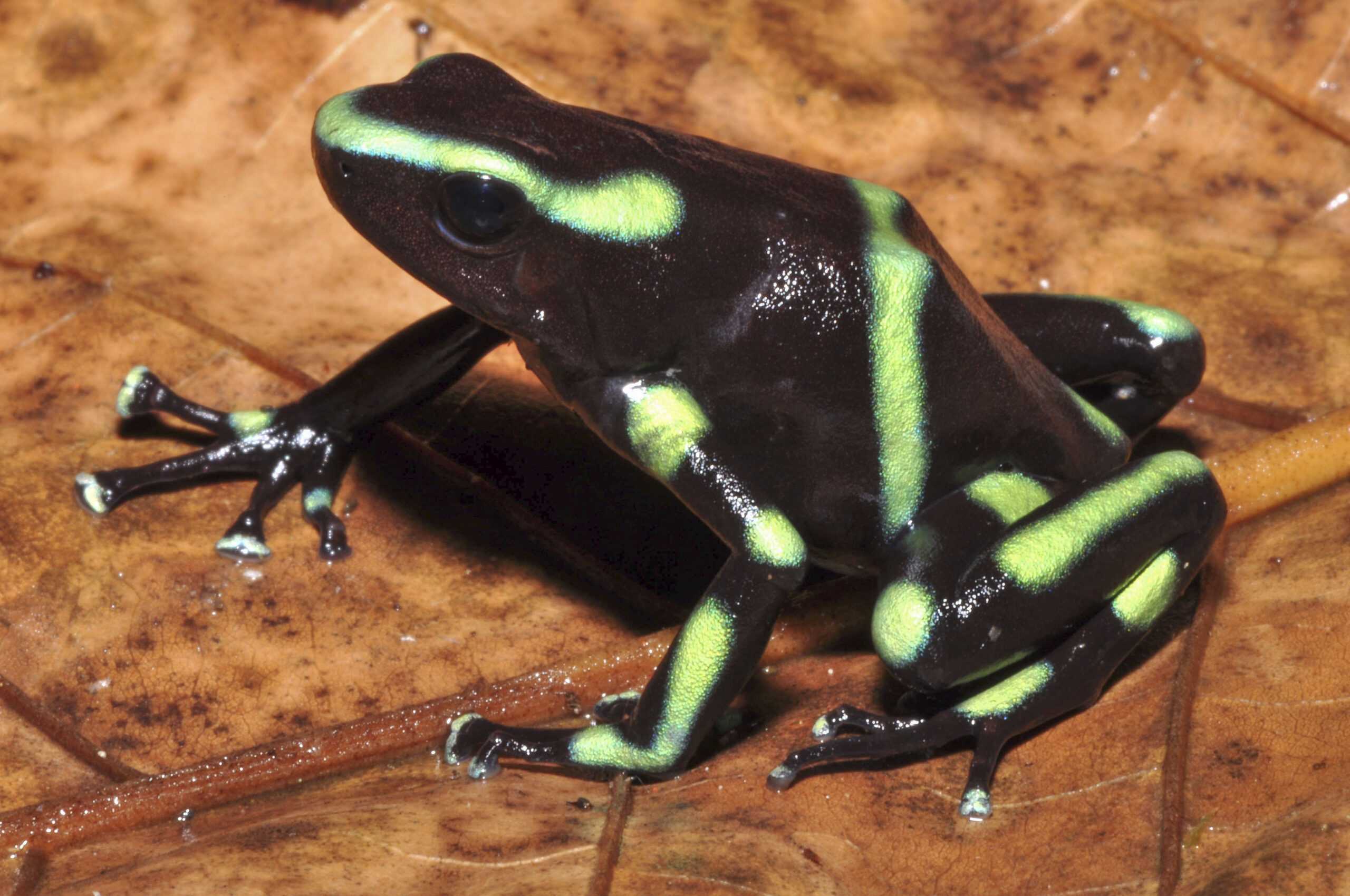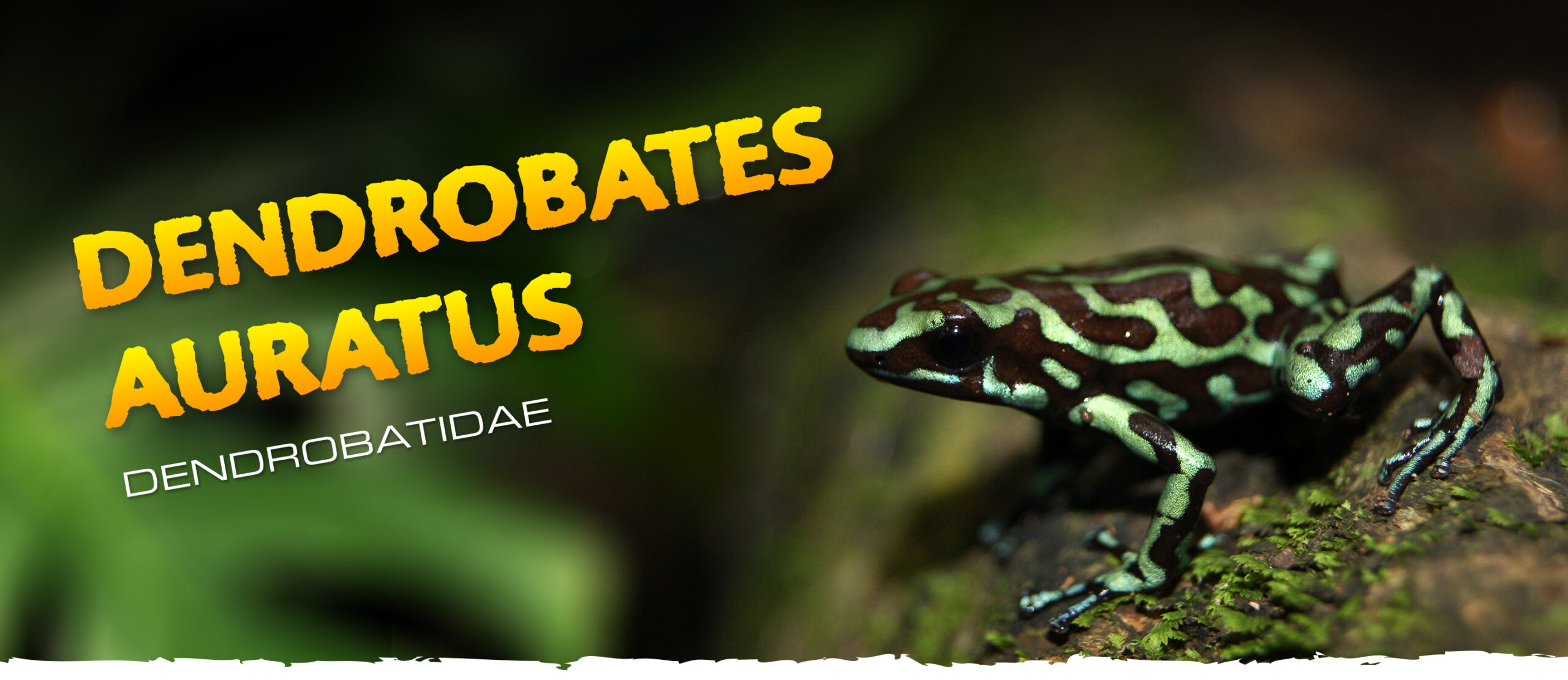
Green-and-black Poison Dart Frog
Dendrobates auratus
LATIN NAME
FAMILY
ADULT SIZE
LIFESPAN
RANGE
HABITAT
TEMPERATURE
HUMIDITY
UVB CHART
SKILL LEVEL
LATIN NAME
FAMILY
ADULT SIZE
LIFESPAN
RANGE
HABITAT
TEMPERATURE
HUMIDITY
UVB CHART
SKILL LEVEL
The species is known for its colour polymorphism. Shades of green, blue, yellow and even white are among the possible base colours. The colour of the darker splotches ranges from bronze to black. Like other poison dart frogs, their bright colours are actually a warning sign to inform predators that they are poisonous and should not be eaten (aposematic coloration).
Green-and-black poison dart frogs live a mainly terrestrial lifestyle: they are bottom dwellers that spend most of their time on and in between the leaf litter that covers the forest floor. They do, however, also frequently climb vines and trees.
Their amazing colours and the fact that they are easy to care for makes them appealing display animals for both the beginning reptile enthusiast as well as for the advanced hobbyist. Green-and-black poison dart frogs are best kept as pairs or groups consisting of a majority of males: females might express dominant and aggressive behaviour towards other females when there is a conflict of interest in a specific male. The animals might be shy at first, but will quickly become more active when provided with a well-planted terrarium with plenty of hides.
Green-and-black poison dart frogs were first scientifically described in 1855 by the French biologist Charles Frédéric Girard, who was specialised in icthyology and herpetology. They have been captive bred in the USA and Europe for more than 40 years.
The name “dendrobates” originates from the greek words dendro (tree) and bates (walker or climber), which refers to the way these frogs are moving trough the lower vegetation layers, climbing into low bushes and tree trunks. “auratus” is Latin and is literally translated as “golden”, and refers to the darker splotches with a bronze- or gold-like shine seen on some of the colour variations.
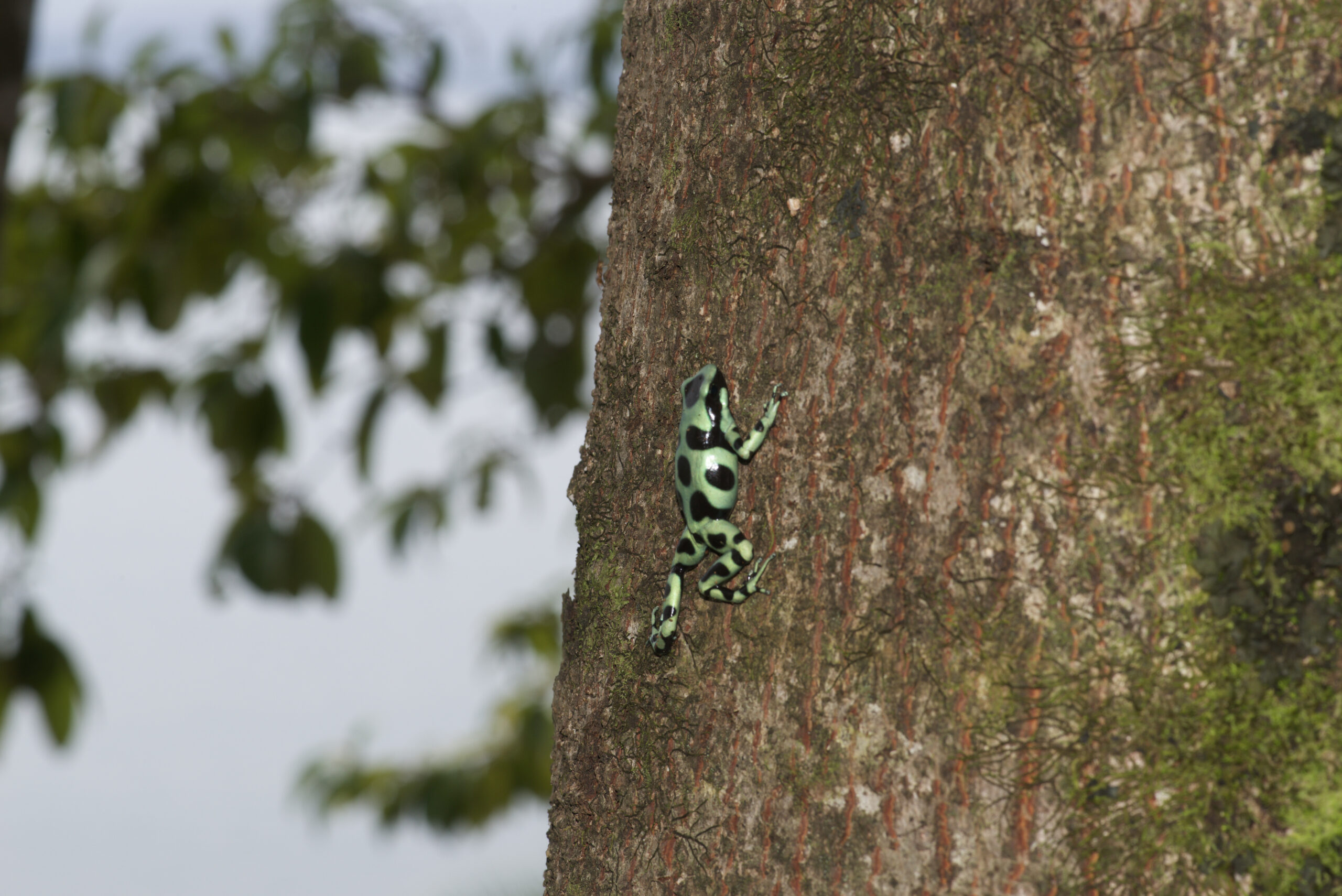
Dendrobatus auratus climbing a tree trunk. - by E. Van Heygen.
Colour polymorphism is defined as colour variation within a species or population. Research suggests this trait positively influences range expansion and species persistence, resulting in a reduced risk of extinction. Shades of green, blue, yellow and even white are among the possible base colours of the Green-and-black Poison Dart Frogs. The colour of the darker splotches ranges from bronze to black. In some colour morphs, the darker colour will be more prominent, making up most of the frogs pattern.
During the mating season, males will look for an appropriate egg-laying site and try to attract females with a soft rattling mating call.
Adult males and females range from 1” to 2″ or 2,5 to 5 cm in total length. It is difficult to distinguish male from female frogs: when they are on the same diet, females will usually grow slightly larger. If well fed & maintained, these frogs can live up to 20 years.
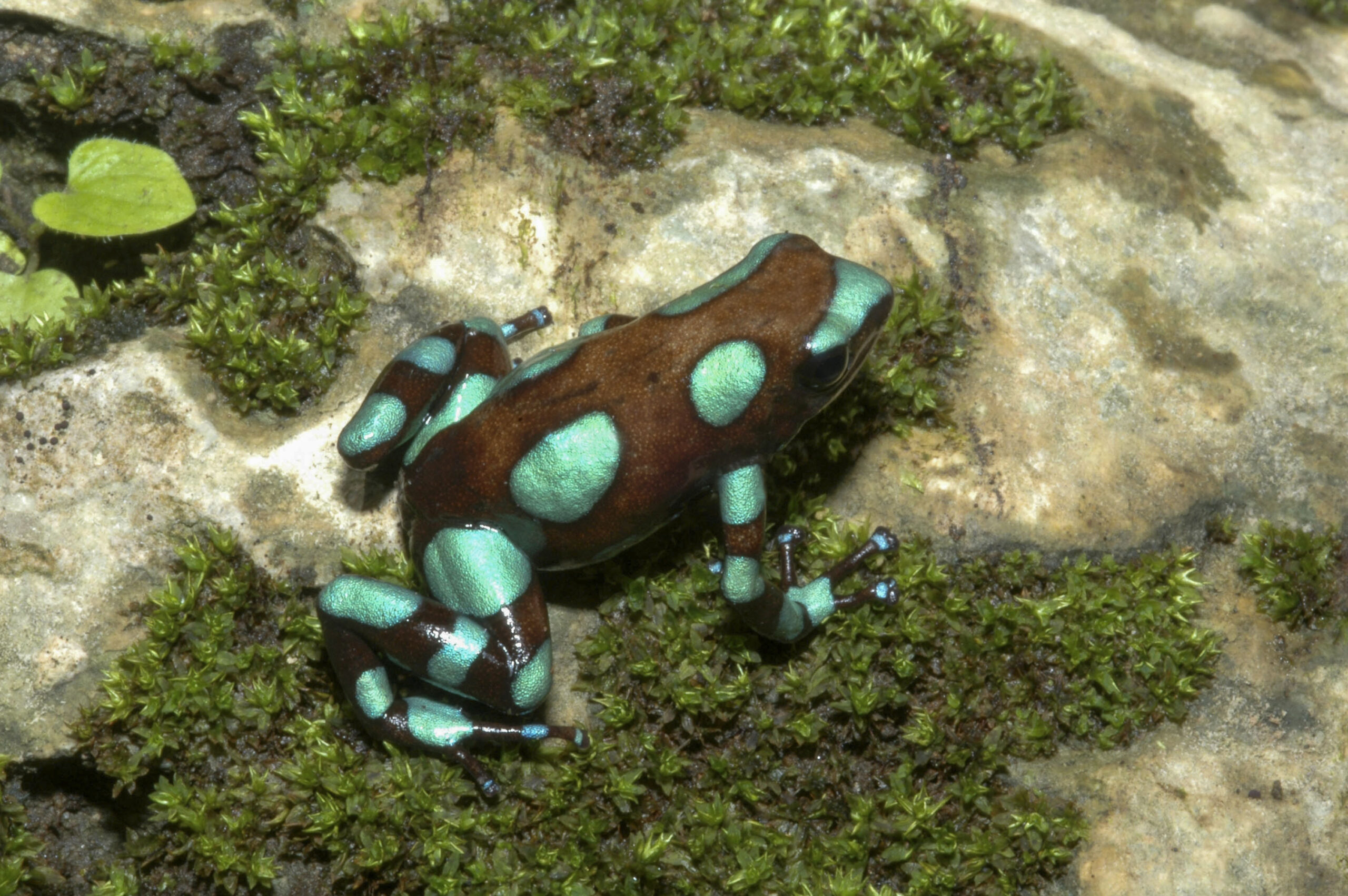
Dendrobates auratus "Lago Bayano" from Panama Province, Panama - by J. Van Der Meulen
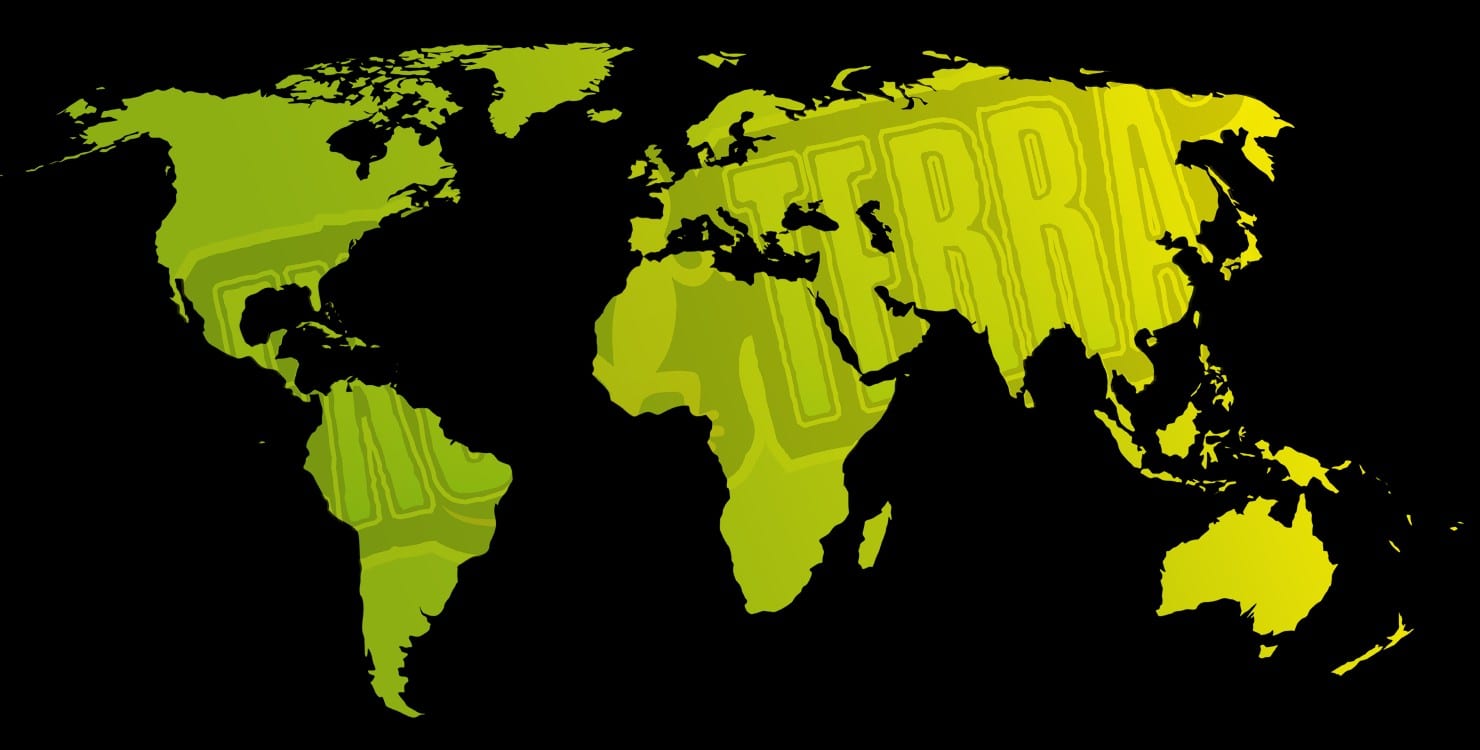
Terrarium
Exo Terra® Natural Terrariums are designed by European herpetologists and offer several housing options for green-and-black poison dart frogs. These glass terrariums feature front opening doors, allowing easy access for maintenance and feeding and a unique double ventilation system with full screen stainless steel top.
The Exo Terra® Natural Terrarium X-Tall (Paludarium) range allows you to create a semi-aquatic terrarium habitat that replicates a rainforest, swamp or stream and can harbour aquatic as well as terrestrial animal and plant species. The bottom part has an extra high front bottom glass, providing a higher water level and an increased water volume compared to common terrariums. A part of the aquatic section can consist of a false bottom to support the land section, accommodate and hide the aquatic appliances like filters, pumps and water heaters and can double as a biological filtration media. Green-and-black poison dart frogs are bad swimmers; to avoid drowning, make sure the water depth of the accessible water parts does not exceed the frog’s height.
The Exo Terra® Frog Terrariums can be set up as a bioactive habitat for dart frogs, smaller tree & reed frogs, newts and salamanders, small geckoes & lizards, garter & grass snakes, etc.
Horizontally oriented enclosures like the Low and Wide Natural Terrariums are a great choice to house a small group of Green-and-black Poison Dart Frogs, since they live a mainly terrestrial lifestyle:
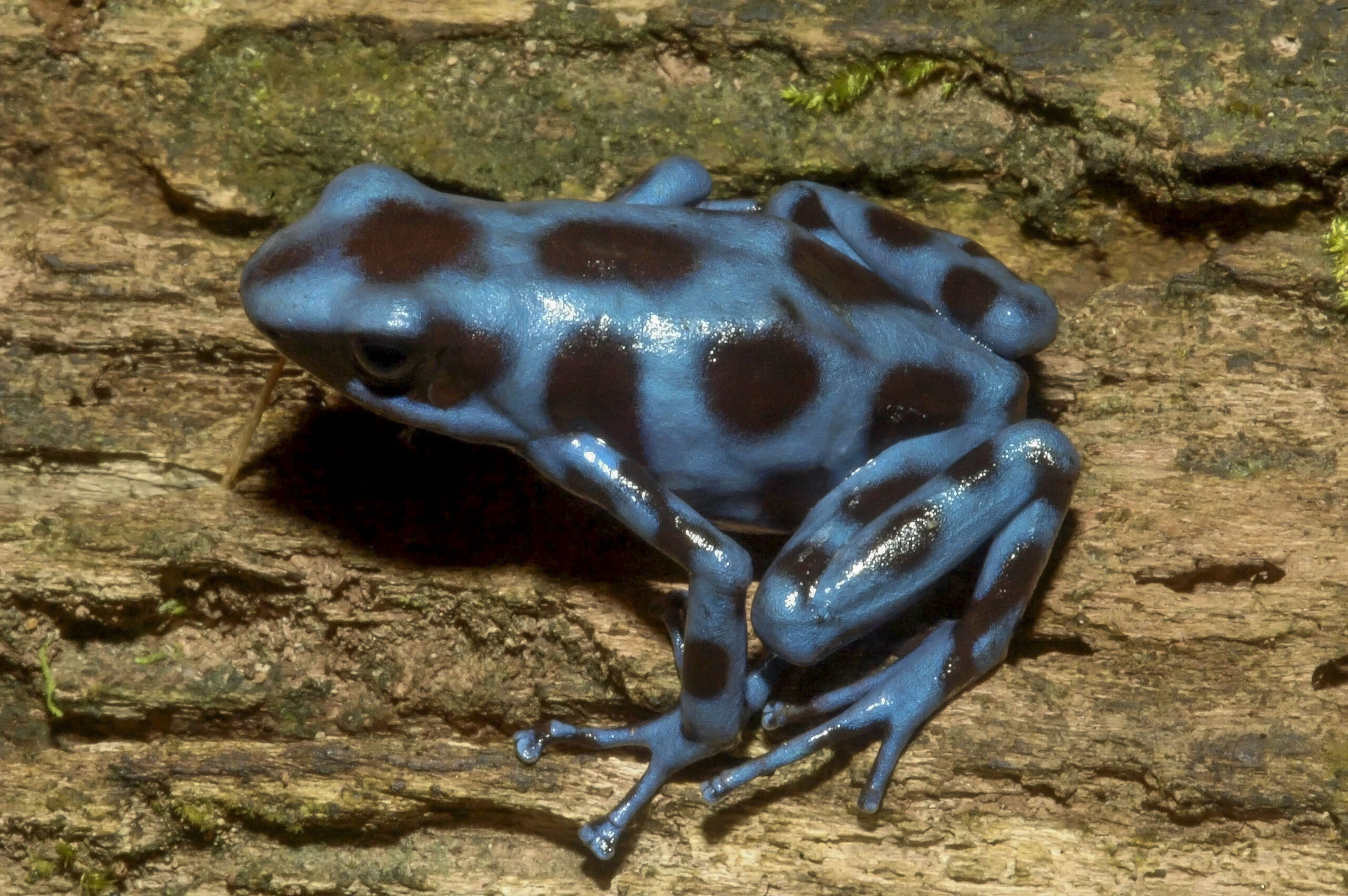
Dendrobates auratus “Calobre” is one of the few blue coloured auratus morphs and lives near the village Calobre in Panama
Animals
PT2745 - Dart Frog Terrarium
PT2603 - Natural Terrarium – Small/Low
PT2605 - Natural Terrarium – Small/Wide
PT2604 - Natural Terrarium – Medium/Low
PT2610 - Natural Terrarium – Medium/wide
Dimensions
PT2745 - Dart Frog Terrarium
PT2603 - Natural Terrarium – Small/Low
PT2605 - Natural Terrarium – Small/Wide
PT2604 - Natural Terrarium – Medium/Low
PT2610 - Natural Terrarium – Medium/wide
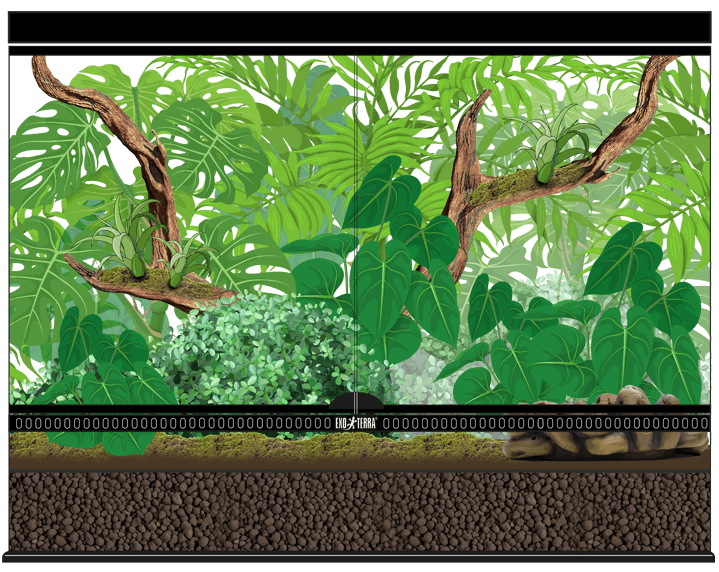
Rainforest Floor Terrarium
The Rainforest Floor Terrarium landscape replicates the understory layer of the equatorial rainforest with an abundance of smaller branches covered with leaves and epiphytic plants like orchids, bromeliads, aroids (Pothos, Philodendron, Monstera, etc.), air plants (Tillandsia spp.), lichens, mosses and ferns. The substrate in this habitat is covered with patches of moss and lots of leaf litter. The Rainforest Floor Terrarium landscape mimics the microhabitat of frogs living in the understory layer of the forest, where only smaller water bodies occur, with no pond, stream or river in the immediate vicinity. This terrarium landscape utilises a water dish (such as the Frog Pond) for hydration and egg deposition. The Rainforest Floor Terrarium habitat can best be replicated in horizontally oriented terrariums.
The set-up can be a simple “forest floor” terrarium or a more natural bio-active type set-up with a separate land and water part mimicking a lakeshore or riverbank, by using the Bio Drain system. With a combination of hides (Coconut Cave), leaf litter (Equatorial Forest Floor substrate) and artificial and live plants you can provide a suitable environment consisting of substrate, foliage and secure hides which will allow the poison dart frogs to live comfortably.
DISCLAIMER In regards to the pet species and number of specimens to be kept in a terrarium, always comply with the species specific Rules and Regulations in your Country of residence.
DISCLAIMER The terrarium should be placed in a room receiving only indirect light from windows. Do not place the Terrarium near a window where it can receive direct sunlight, as this could cause the terrarium to overheat and stress or kill your Poison Dart Frogs.
Lighting
Heating
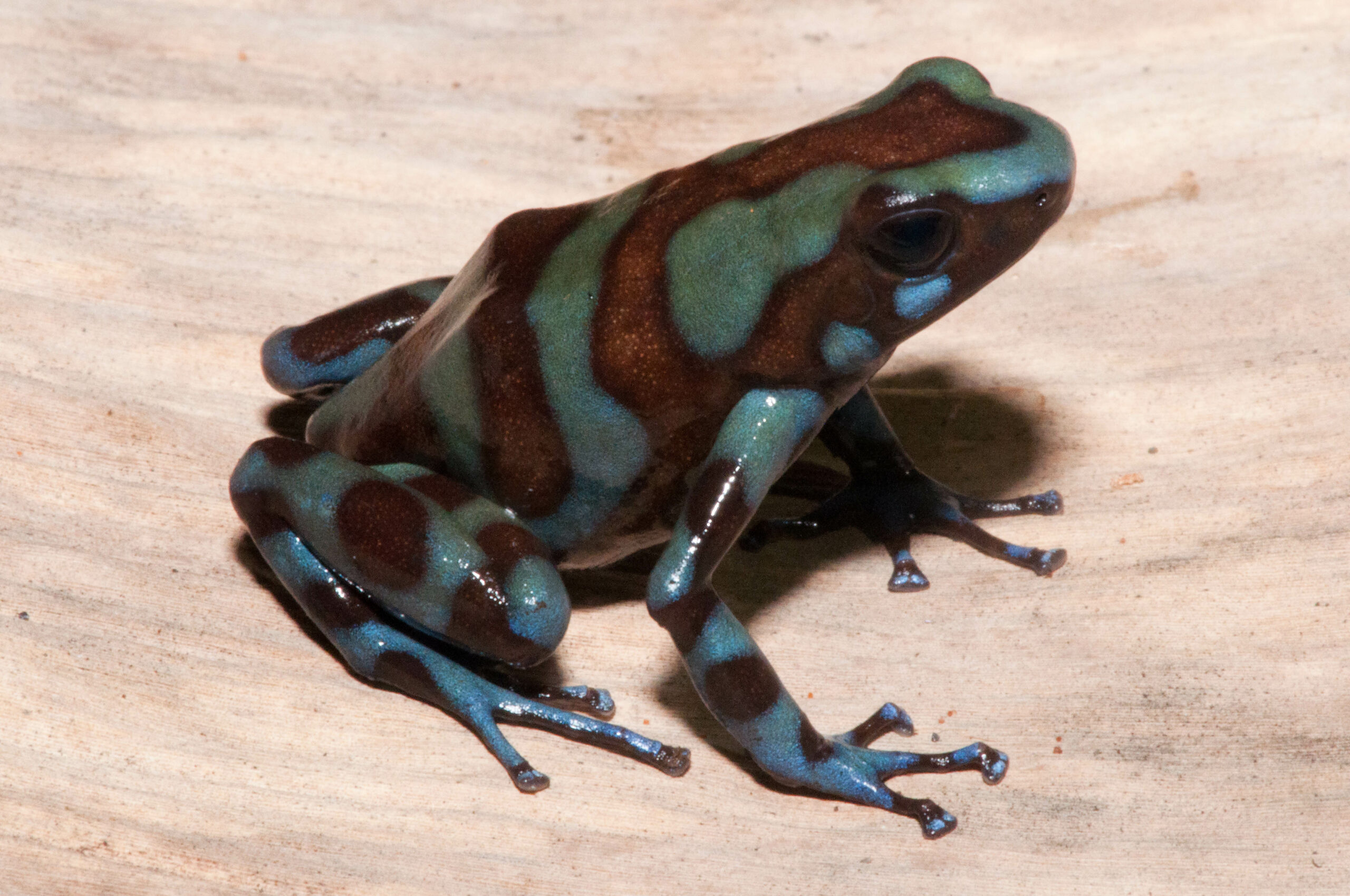
Dendrobates auratus “Bronze” from the Caribbean slopes of the Cordillera Central in Panama.
Monitoring
Substrate
Green-and-black Poison Dart Frogs thrive well in a paludarium setup or in a bioactive terrarium setup with a water dish or preferably elevated waterbodies.
The Paludarium’s living space consists of 3 distinct zones:
Terrestrial Zone The terrestrial zone is a land area with plants, trees, bushes and rocks that never submerges. In tropical climates a variety of invertebrates, reptiles and amphibians occur here.
Riparian Zone The riparian zone or riverbank is the interface between land and water. It is inhabited by semi-aquatic reptiles and amphibians.
Aquatic Zone The aquatic zone can be a stream, pond or even lake – home to turtles, aquatic amphibians, fishes and freshwater shrimps.
The Exo Terra® Sub Stratum is a natural volcanic soil with live beneficial bacteria. The porous surface and low density structure allow for excellent drainage and aeration, but it also promotes a flourishing population of beneficial, nitrifying bacteria, creating a self-sustaining, living terrarium ecosystem. The active beneficial bacteria of the soil will decompose biological waste, keeping the terrarium clean and healthy. By mixing the Sub Stratum with other organic substrates, you enrich any substrate with the required minerals like calcium, nitrogen, potassium and phosphorus. It also aids in the water retention capacity and provide adequate air supply to the roots.
The Exo Terra® Equatorial Forest Floor is a multi-layer substrate that allows you to recreate the forest floor as found in natural equatorial forests. The Equatorial Forest Floor provides a base layer and a top layer. The base layer consists of a rich organic matter from ground coconut husk fiber. It is a 100% natural, ecological and biodegradable substrate with great hygroscopic properties. The top layer consists of sun dried decorative Ardisia leaves from a sustainable resource. The top layer covers the actual substrate underneath to facilitate its moisture retention and prevent the soil from drying out.
The Exo Terra® Forest Moss is real compressed moss grown in tropical Asia and does not contain any dyes or chemicals. This ecological substrate is extremely absorbent and ideal for increasing humidity in the terrarium. It is totally safe for use with frogs, salamanders and burrowing or digging animals.
The Exo Terra® Plantation Soil is a 100% natural, biodegradable terrarium substrate made from sustainable, ground coconut husk fiber grown on plantations in tropical Asia. The unique hygroscopic properties of this ecological substrate regulate the terrarium’s humidity in a natural way and is totally safe for frogs, salamanders and other burrowing or digging animals. The unique coir pith used for the Exo Terra® Plantation Soil consists of a mixture of short fibres and coco-peat grain sizes ranging from coarse granules to fine clumps resulting in improved soil drainage and aeration. The improved aeration of the substrate promotes the cultivation of healthy waste-reducing organisms keeping your terrarium fresh and clean.
The substrate should be kept moist at all times, but definitely not soaking wet. Make sure to offer different gradients of moisture inside the terrarium. Some parts can be kept rather moist while other parts should be kept somewhat drier. Also, try to vary the moisture depending on the season, spray more frequently during the warmer parts of the year.
The Exo Terra® substrates will help maintain the substrate moisture at an optimal level. Providing a top layer of Exo Terra® Equatorial Forest Floor or Forest Moss will also facilitate the substrate’s moisture retention and prevent it from drying out. The ardisia leafs or forest moss also provides hiding spots for the reptiles and amphibians foraging the forest floor and at the same time, facilitate the natural ecosystem where beneficial organisms will break down waste products and thus reduce odours.
The secret to growing healthy plants begins with the soil. Naturally, healthy soil contains living microorganisms — from bacteria to fungi, protozoa and arthropods. Together they form a choreographed exchange from the recycling of nutrients to the decomposition of organic materials.
Plants
The land part of the terrarium can partially be decorated with live and/or Exo Terra® artificial or smart plants. Live plants and moss will contribute to the filtration capacities of your terrarium. This type of setup allows you to create an effective filtration system, mirroring the process of natural biological filtration. A fully functioning aqua-terrarium or paludarium will provide a constant source of clean water, which is imperative to keep semi-aquatic species. It is basically a small, closed ecosystem.
Ideal for Poison Dart Frogs are small fern species and epiphytes like Bromelias, Tillandsias and orchids. Combine this with live moss and small-leaved vining plants to create a varied planted setup.
The Exo Terra® Dart Frog Bromelia is a very realistic bromelia as found in most frog habitats. The overlapping waxy leafs provide an ideal platform for the female frogs to deposit their eggs. The urn-like rosette retains water, used by the frogs as pools and to deposit their tadpoles, and is detachable for easy cleaning or for collecting the tadpoles.
Many hobbyists choose to introduce live plants in pots that are buried in the substrate and concealed with decor items, like cork bark or rocks. The Exo Terra® Snake Bowl can be used as a decorative planting pot. Its extra deep design makes it suitable for small to medium live terrarium plants.
DISCLAIMER Make sure the plants have no pests before introduction and rinse leaves thoroughly to remove any pesticide residues.
Exo Terra® offers a wide range of artificial plants with the same advantages as live plants; they’re decorative, they provide shade, and they create hiding spots and visual barriers to let your reptiles and amphibians experience an increased feeling of safety and reduced stress. Exo Terra®’s artificial plants are exact copies of their natural counterparts to blend in well with live plants but are much easier to maintain. A combination of live plants and Exo Terra®’s artificial plants allows you to fully plant a terrarium, even in the hottest or driest parts.
Exo Terra®’s Bromeliads, Scindapsus, Philodendron and hanging Plants are easy to clean & maintain, while the weighted base of the Bromeliads, Scindapsus, Philodendron allows you to easily position the plant after maintenance.
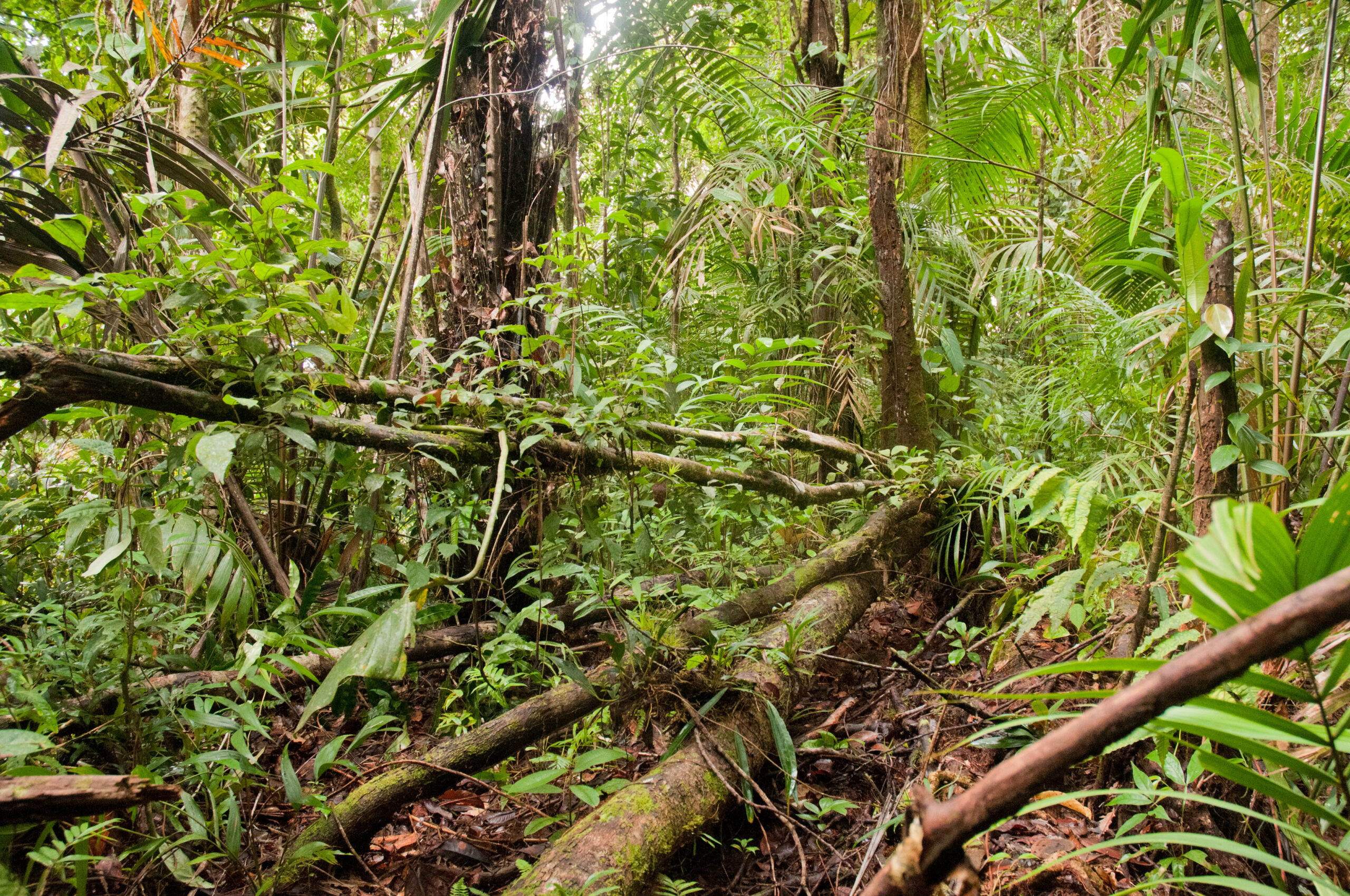
Natural habitat of Dendrobates auratus.
Hide-outs
Although Green-and-black poison dart frogs might be shy by nature, they will quickly become more visible when provided with plenty of hides. Poison dart frogs are easily frightened creatures that hide rather quickly, at the slightest disturbance of their surroundings. Strangely enough, they will show up in the open much more if provided with ample secure hiding places; it will make them feel safe and secure knowing their comfort zone is within immediate reach. The Exo Terra® Coconut Cave is the perfect hiding and egg-laying cave for your poison dart frogs. In a constantly moist environment, its irregular surface will slowly start to overgrow with moss, adding to the natural look of the cave.
Decor
Landscaping a terrarium will not only encourage the frog’s activity and exploratory behavior, but also provide extra cover, which increases the frog’s sense of security and reduces its stress levels.
Next to the necessary items like leaf litter, plants and hideouts – the terrarium can be “beautified” with some additional decor items. Care however needs to be given to not over clutter the open space in the terrarium.
Waterfalls and Cascades add aesthetic appeal and will help oxygenate and biologically filter the water.
Exo Terra offers a wide variety of innovative decor items like Skulls, Waterfalls, Smart Plants, Ground Cover Plants, etc. – all which add next to personalising accents, some more environment enrichment and features.
Diet
Hydration
The presence of clean and fresh water is important for the proper care and maintenance of captive reptiles and amphibians.
Dart frogs have a thin, highly permeable skin, which makes them susceptible to dehydration and sensitive to toxic chemicals. Instead of drinking, they absorb water through their skin to stay hydrated. As a consequence, a high humidity should be maintained inside the terrarium and extra attention must be paid to the water quality. Always treat tap water with Exo Terra® Aquatize to remove harmful heavy metals, chlorine and chloramines, necessary to provide safe healthy water for your amphibians. In a bio-active set-up you can use Turtle Clean (PT1998) to add beneficial organisms to the terrarium water and speed up the biological filtration capabilities. Liquid Electrolyte and Calcium can be added to the water to support healthy bone and muscle growth in your frogs and especially tadpoles.
A shallow Water Dish with clean, de-chlorinated water should be available at all times. Exo Terra® Water Dishes, and specifically the Exo Terra® Frog Ponds are ideal because they are shallow, have a natural appearance and are easy to clean and disinfect. The Frog Pond’s unique shape allows you to install the pond semi-recessed in the substrate to mimic a riparian zone. This design offers easy access for dart frogs to hydrate while the shallow water body and integrated steps prevent the animals from drowning.
Green-and-black poison dart frogs can’t swim so make sure that the maximum depth of the Water Dish or other water bodies in your terrarium does not exceed the height of the frog. If necessary, add Exo Terra® Turtle Pebbles to decrease the water depth.
The average humidity should be kept between 70-80% with peaks of 100% in the morning and evening (when the terrariums is sprayed/misted), similar to what these frogs experience in nature. The Exo Terra® Monsoon is a handy device to guarantee that your frog terrarium is sprayed at a set time every day. The Exo Terra® Humidifier can help maintain the correct relative humidity in the terrarium, especially if used in combination with the Exo Terra® Thermostat & Hygrostat. Although a high humidity is mandatory, a minimum of ventilation is required to avoid the growth of fungus and rotting of plants. The patented dual ventilation system of the Exo Terra® Natural Terrariums and Frog Terrariums provides the ideal amount of ventilation, without compromising the required relative humidity.
Maintenance
Land area;
Spot-clean your Green-and-black Poison Dart frog’s enclosure once a week, or more if necessary, in order to prevent harmful bacteria to build up; remove fresh or dried faeces, leftover foods, etc… For a more thorough cleaning, remove all the decor pieces and clean these with warm water. Stirring and mixing the moist substrate will allow soil bacteria to break leftover traces of waste down. Always keep a keen eye on the substrate; as long as the substrate is not degrading or does not have a foul odour, the spot cleaning process is sufficient. Once the substrate starts to degrade or spreads a foul odour, it needs to be replaced completely.
Water part;
When using a water circulation pump or filter, it is best to clean the water inlet and filter media every 2-3 weeks to ensure optimal performance. Water changes should be performed on a bi-weekly basis; remove about ¼ to ⅓ of the water and replace it with fresh water of the appropriate temperature. Partial water changes can help to remove toxic substances or improve the overall water quality. Unless really necessary, make sure to never perform entire water changes, as this will also remove beneficial bacteria and organisms. Always treat tap water with Aquatize to remove harmful heavy metals, chlorine and chloramines when performing water changes. Use Turtle Clean (PT 1998) to assure that the beneficial organisms in the terrarium water remain at an ideal level to keep the biological filtration system performing well.
Juvenile Dart Frogs should be fed daily, while adults only need feeding every other or third day.
The terrarium should be misted at least twice a day, depending on the relative humidity, preferably with purified or distilled water to prevent mineral stains on the glass.
Live plants should be watered once a week whether in pots or planted directly in the substrate.
Clean the inside glass and decoration once or twice a week with plain water to remove any waste matter. The outside (NEVER the inside) glass can be cleaned with a paper towel and window cleaner.
Breeding
In the wild, the breeding season of Green-and-black Poison Dart Frogs coincides with the rainy season, which lasts from May to November. To stimulate breeding, simulate the rainy season after a drier period by increasing both length and number of the spray intervals of your misting system.
Unlike other frog species, amplexus does not occur in dart frog species. The male Green-and-black poison dart frog will look for an appropriate egg-laying site: often a dark hide with a smooth bottom surface. Hides such as the Exo Terra® Coconut Cave are the perfect egg-laying cave for your poison dart frogs. Once the male finds a suitable site, he will try to attract a female with a soft rattling mating call. The female will follow the male towards the selected site, where she will lay 5 to 20 eggs, upon which the male will fertilise them.
Once the tadpoles start swimming they will start feeding on frog & tadpole food, dead insects, chopped earthworms, fish food flakes, algae, plants, etc… It takes the tadpoles aproximately 2-4 months to fully metamorphose into air-breathing amphibians. In this stage it is critical to provide the metamorphosing tadpoles with sufficient plants, branches or a smooth levelled riverbank so they have easy access to the land area.
The newly-emerged froglets will absorb the remnants of their tail for the next few days and will start feeding on food items of appropriate size like fruit flies and aphids. As with adults, always dust your feeder insects with a 1:1 mix of Exo Terra® Multivitamin and Calcium +D3 powder supplement. The freshly metamorphosed frogs can be raised under similar conditions as used for the adult frogs, just make sure the water isn’t too deep, and there are slopes available so the frogs can easily climb onto land areas.
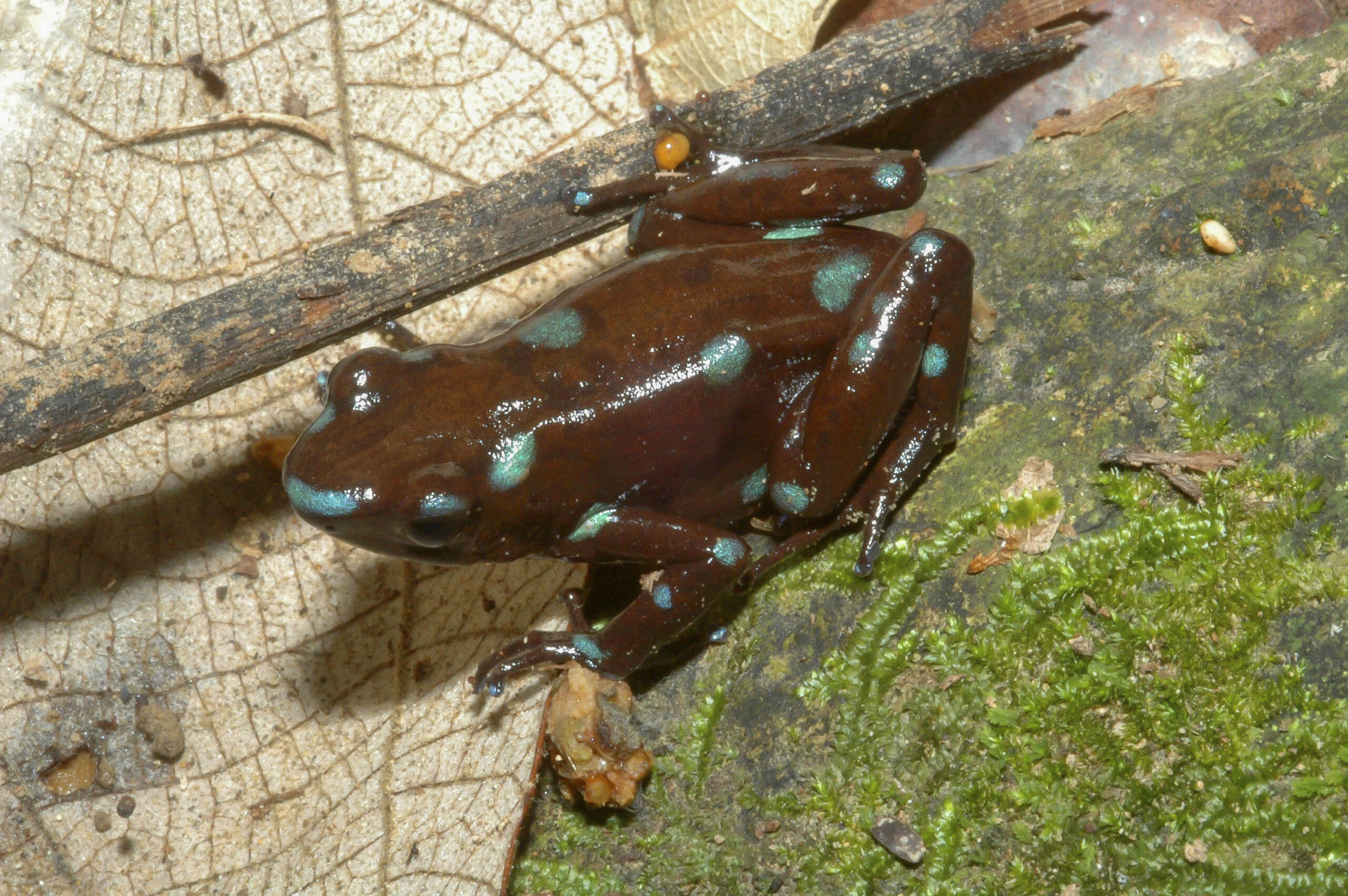
Dendrobates auratus “Canal” is widely distributed and occurs along both sides of the Panama Canal
Handling
We don’t recommend the handling of Poison Dart Frogs when not necessary. Extra care should be taken when handling wild caught animals, as their skin can keep its poisonous characteristics up to several years after their introduction into the terrarium. We recommend using rubber gloves when handling wild caught Poison Dart Frogs.
Poison Dart Frogs are animals that are best observed, as they do not appreciate being picked up or handled. When manipulating Dart Frogs, they will quickly become stressed. Like most amphibians, Dart Frogs have a very sensitive skin, and are especially sensitive to chemicals like soap, lotion, etc… so make sure to always thoroughly wash and rinse your hands with warm water before and after handling any amphibian.
Every amphibian’s skin contains very mildly toxic substances that can irritate eyes or open wounds so always thoroughly wash and rinse your hands with warm water before and after handling any amphibian. If you accidentally touch your eyes while handling an amphibian, you might experience a somewhat burning sensation. Should this happen, make sure to rinse your eyes immediately and thoroughly with water, that should relief the burning sensation immediately.
Conclusion
Green-and-black Poison Dart frog’s are long-lived, colourful and “easy-to-care-for” amphibians making them an ideal beginner’s animal. The various colour & pattern morphs make these frogs great display animals, especially when housed in a well-decorated, planted terrarium. Thanks to their small size, they will not damage fragile plants like orchids. This allows you to create an interesting, exiting and colourful piece of rainforest-like ecosystem, inhabited by both plants and animals.
Green-and-black Poison Dart Frogs have been captive bred in the USA and Europe for more than 40+ years, and captive bred youngsters are readily available in reptile stores as well as from breeders.
Did you know?
Tips
Misting can be automated with the Exo Terra Monsoon, a programmable misting system suitable for all types of terrariums. It helps maintain optimal humidity by generating a fine mist at programmed intervals, the duration and frequency of which can be easily adjusted.
Use the Exo Terra® Terrarium Cleaner & Deodorizer to clean water dishes and decor items. It removes organic stains and odours, without any risk to your frog.
Is a Green-and-black Poison Dart Frog the right choice for me?
Green-and-black Poison Dart Frogs are great animals; they are beautiful, long-lived and “easy-to-care-for”, on top of that, they come in a variety of color & pattern morphs. Keep in mind that Green-and-black Poison Dart Frogs are display animals, they don’t like to be handled. If you are intrigued by the rainforest ecosystem, they are the perfect choice. Their small size does not endanger the wellbeing of fragile plants like orchids, which allows you to recreate a complete piece of this beautiful ecosystem, including live plants, flowers and mosses. Green-and-black Poison Dart Frogs are readily available and they’re captive bred, making them safe animals to start with.
Can I keep other species of amphibians and reptiles together with my Green-and-black Poison Dart Frogs?
Hobbyists have reported good as well as bad experiences in regards to keeping this species together with other species. In general we would advise that Green-and-black Poison Dart Frogs should definitely not be kept together with other bottom dwelling and/or diurnal species, as this could create a stressfull environment.
Can I feed my Green-and-black Poison Dart Frogs wild caught insects?
Should I feed a variety of food items to my Green-and-black Poison Dart Frog or can I stick to just 1 type feeder insect?
Bring as much as possible variation in your Green-and-black Poison Dart Frog’s diet to make sure that your frog receives all possible essential nutrients.
Are Green-and-black Poison Dart Frogs poisonous?
Poison dart frogs that are bred in captivity do not pose a risk of poisoning. The frogs are fed with fruit flies, springtails, aphids and other tiny invertebrates, which lack the toxic substances that are used by their wild counterparts to store in their skin. On the contrary, when handling wild caught frogs, precautions should be taken, as it might take up to several years before all the toxins have disappeared.

